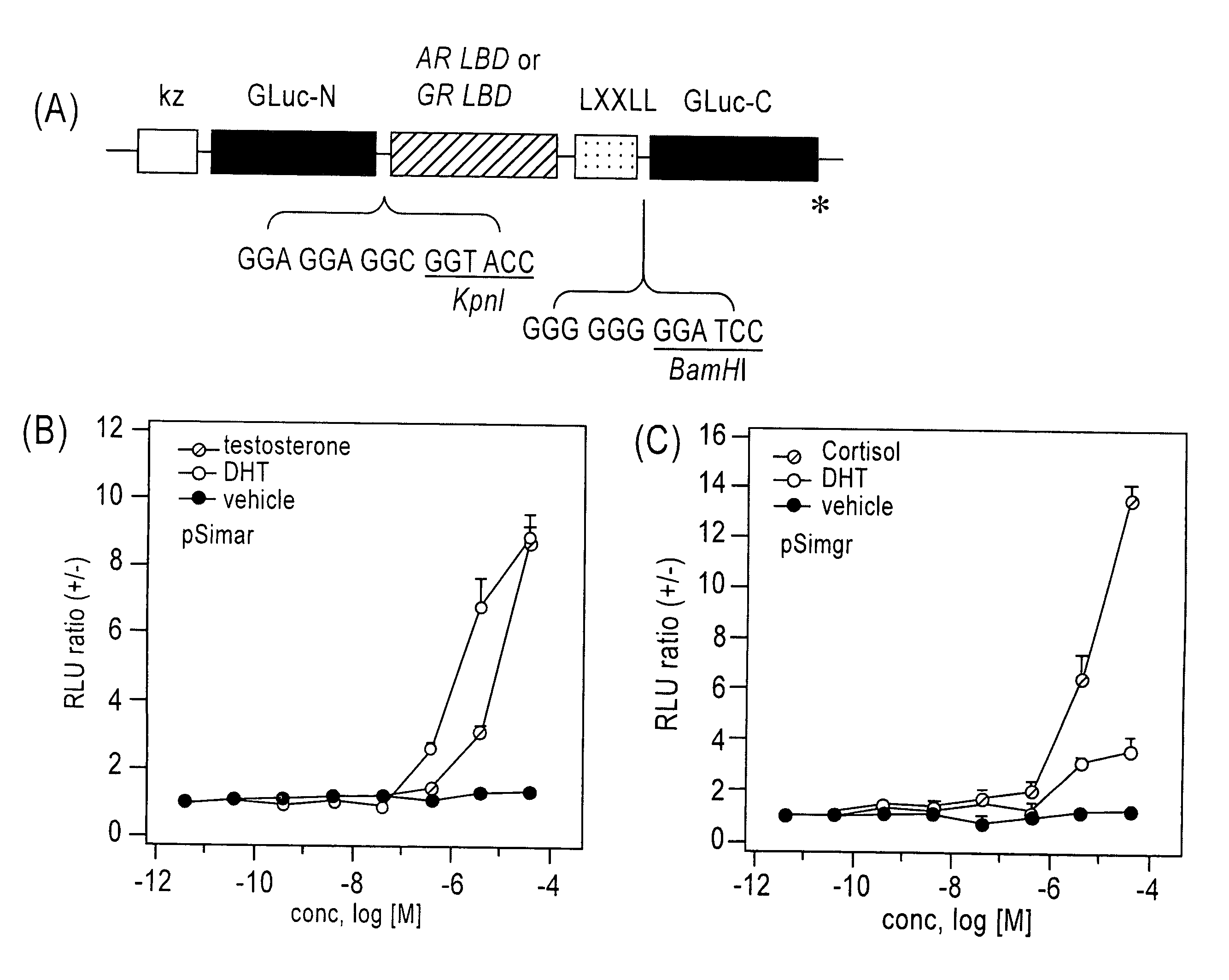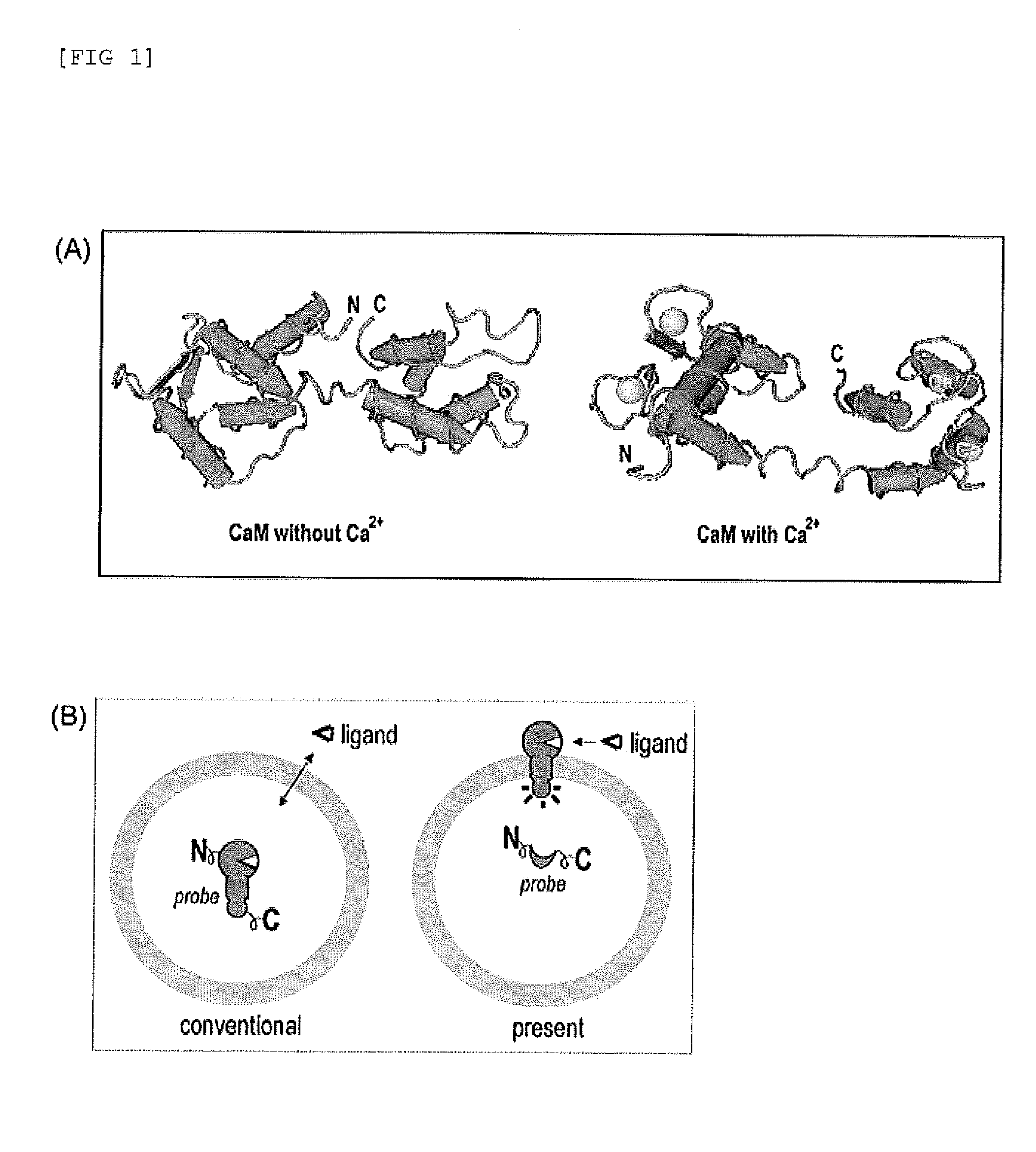Single-molecule-format real-time bioluminescence imaging probe
a single-molecule, luminescence imaging technology, applied in the direction of animal/human proteins, peptides, enzyme stabilisation, etc., can solve the problems of lack of selectivity to target ligands, cytotoxicity, and difficulty in living subjects to perform bioanalysis, etc., to achieve convenient bioluminescence analysis, wide range of bioanalysis, and efficient
- Summary
- Abstract
- Description
- Claims
- Application Information
AI Technical Summary
Benefits of technology
Problems solved by technology
Method used
Image
Examples
example 1
Construction of Plasmid Carrying Nucleic Acid Molecules which Encode Various Fusion Proteins for Single-Molecule-Format Luminescent Probe Containing Calmodulin (CaM) for Ca2+ Recognition
[0125]The subject probe which is capable of imaging, on a real-time basis, the response phenomena induced by external stimuli in living cells, will be designated as Simor probe, based on its name in English (a SIngle-MOlecule-format bioluminescent probe for Realtime imaging). A probe comprising calmodulin (CaM) will be designated as Sica. On the other hand, a probe comprising calmodulin as well as calmodulin recognition peptide sequence (M13), will be designated as Sicam. The eukaryotic expression vectors incorporated with the respective probes will be respectively designated as pSica and pSicam.
[0126]PCR amplification was carried out to introduce KpnI and BamHI, which are restriction enzyme sites, into the two termini of a cDNA encoding calmodulin, which is a Xenopus laevis (African clawed frog)-der...
example 2
Examination of Partition Site of GLuc
[0131]The inventors of the present invention presupposed, on the basis of the analysis of hydrophilicity distribution search in the total amino acid sequence of GLuc, that a hydrophilic region of amino acid residues at positions 90 to 108 in the amino acid sequence of GLuc was the region between the two protein domains constituting GLuc. Thus, the inventors determined five partition sites inside the above-mentioned region, and produced five fragment pairs by fragmentizing five sites of the cDNA of GLuc by PCR reaction, as previously described (FIG. 3).
[0132]The plasmids carrying only CaM between these five pairs of N-terminal fragment and C-terminal fragment of GLuc, were referred to as pSica series, and the plasmids were respectively designated as pSica-1 to pSica-5 in accordance with the different partition sites.
[0133]The luminescence values of the respective probes were compared, and the luminescence values of the probes having partition site...
example 3
Production of Point-Mutated Type Probes and Determination of Luminescence Spectrum Thereof
[0135]There exists a sequence of seven amino acid residues (93RCHTYEG99) between the dissection sites #3 and #4 of GLuc. In this experiment, N-terminal fragments each having a single point-mutated to glycine (G), were produced in order to search, among those seven amino acid residues, for the amino acid which is responsible for the luminescence activity of GLuc. Thus, six kinds of plasmids were produced using the nucleic acids which respectively encode the fusion proteins comprising a single point-mutated amino acid in the GLuc-N-terminal fragments.
[0136]To produce these point mutants, the following procedure was conducted. PCR-based synthesis of a cDNA encoding RCHTYEG, which is a portion of the amino acid sequence of the N-terminal fragment of GLuc, was carried out using pSica-4 as a template, and primer systems which generate the respective point mutations. The mutated N-terminal fragments t...
PUM
| Property | Measurement | Unit |
|---|---|---|
| Conformational barrier | aaaaa | aaaaa |
| Concentration | aaaaa | aaaaa |
| Wavelength | aaaaa | aaaaa |
Abstract
Description
Claims
Application Information
 Login to View More
Login to View More - R&D
- Intellectual Property
- Life Sciences
- Materials
- Tech Scout
- Unparalleled Data Quality
- Higher Quality Content
- 60% Fewer Hallucinations
Browse by: Latest US Patents, China's latest patents, Technical Efficacy Thesaurus, Application Domain, Technology Topic, Popular Technical Reports.
© 2025 PatSnap. All rights reserved.Legal|Privacy policy|Modern Slavery Act Transparency Statement|Sitemap|About US| Contact US: help@patsnap.com



